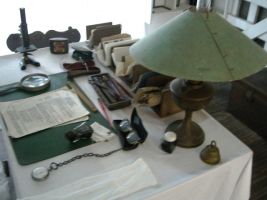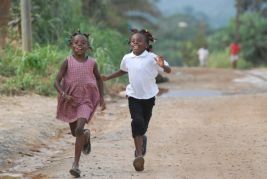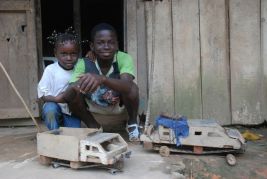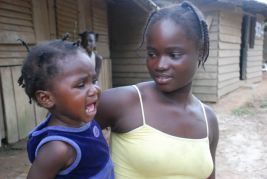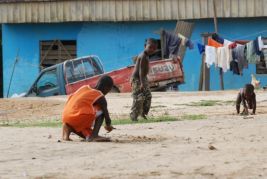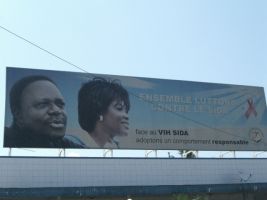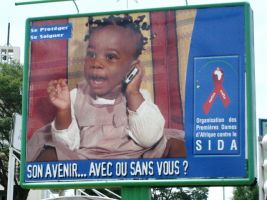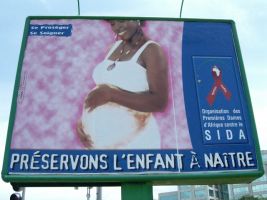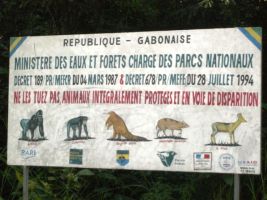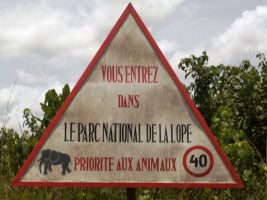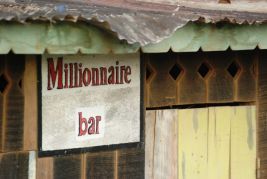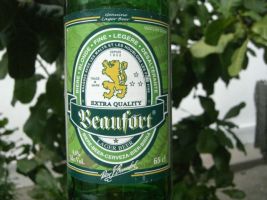
 Italia
Italia France
France Spain
Spain Morocco
Morocco Mauritania
Mauritania Senegal
Senegal Mali
Mali Burkina
Burkina Ghana
Ghana Togo
Togo Benin
Benin Nigeria
Nigeria Cameroon
Cameroon Gabon
Gabon Sao Tomè
Sao Tomè Gabon 2
Gabon 2 Congo
Congo Congo DCR
Congo DCR Angola
Angola Namibia
Namibia Sud Africa
Sud Africa Namibia 2
Namibia 2 Botswana
Botswana Zimbabwe
Zimbabwe Botswana 2
Botswana 2 Sud africa 2
Sud africa 2 Swaziland
Swaziland Mozambico
Mozambico Malawi
Malawi Tanzania
Tanzania Rwanda
Rwanda Uganda
Uganda Kenya
Kenya Etiopia
Etiopia Sudan
Sudan Egitto
Egitto Libia
Libia Tunisia
Tunisia Malta
Malta
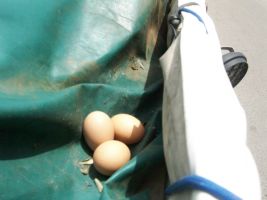
Back to our K7!
Here we are again back with our LandyK7 that in the meantime has been a home for chickens…
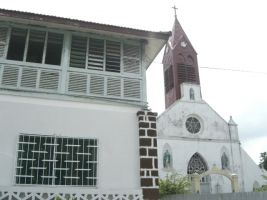
We found a safe place for it in the courtyard of the cathedral.
This is the oldest church in Gabon that dates back to the late 19th century.
The red iron steeple was built later.
Some say that it was made with material that came from Paris, from the Eiffel Tower.
Others say that the architect only drew the plans for the project whilst the material came from a ship that was wrecked during a storm in the gulf.
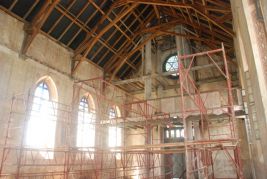
David and P. Ruggero
Here we meet David and P. Ruggero.
We share a pizza and spend an evening of impassioned conversations.
They then tell us of a terrible practice that is still evident here in Gabon.
The sacrifice and torture of children for reasons of appeasement.
Like a black Mass with young victims.
We have the documentation and the evidence.
We will reveal more in our book.
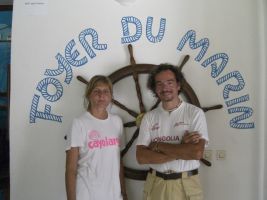
The Good Life…
Sandro, Luca and Lorenzo live here and remarkably, they run a pizzeria by the sea and a high-quality hotel. We owe much gratitude and fondness for the interesting conversation, the conservation of our “fresh stuff” in their fridge during the trip to Sao Tomè, a lovely hot shower, a washing machine and a wonderful night’s sleep.
An unexpected welcome, and for this reason we appreciate it even more.
The pizzeria “La dolce vita” is opposite the cathedral, in Port Molè.
The hotel “Foyer de Marin” is in the Owendo neighbourhood.
GPS N0°17.500 E9°30.300
Doc. A. Schweitzer - Lambaréné
In 1913 Albert Schweitzer disembarked on the shores of Lambaréné, an island in the middle of the Ogooué River. He would build a hospital that would change the life of the inhabitants of this region.
He would spend all of his life in this area as a physician, musician and philanthropist. He would receive the Nobel Award for Peace in 1952.
Today, the hospital is still functional and is still run by the foundation that carries his name. There is also a small museum with a few of his personal possessions.
It is all very interesting, but could definitely be better kept and valued more.

We camp near the Spanish 'Missione dell’Immacolata Concezione'. (Mission of the Immaculate Conception)
Nice grounds and clean services.
5000francs.
GPS S 00°41,516’ E 010°13.682’
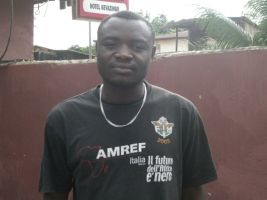
A new heading North
We head back towards Ndjole, but this time we decide to stay outside the city.
We find hotel Kevzingo; it looks pretty much like an African hotel. A nice young manager, who happens to be a brilliant cook, manages it.
The restaurant is small, clean and well ordered.
Originally from Cameroon he came here looking for his fortune.
GPS S0°09.913 E10°46.656
It is quite early and so we go walkabout. The atmosphere is akin to “Il Sabato nel villaggio” (poem by Italian poet Giacomo Leopardi)
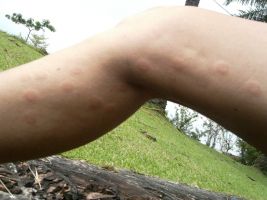
Itchy Swollen Lumpy Bites
Here, insects go out of there way to oblige with itchy lumps and bumps.
And it is not just the poor mosquitoes; they are only partly responsible for the damage.
At least with mosquito nets we can attempt to stop them.
Moreover, flies, midges, ants, fleas, spiders, FURU, and who knows what other creepy crawlies the “Good Lord” has spread amongst us, to meet up and feast on our blood.
I counted 47 fresh bites… only on my right arm!!!
THE BEAUTY OF AFRICA EH?

The rivers we cross in the forest are nearly bursting their banks.
It is just as well, there are no fords to cross
They tell us that the South of Angola and the North of Namibia were flooded until a few weeks ago.
We take our time travelling south and wait for the ground to absorb the water.
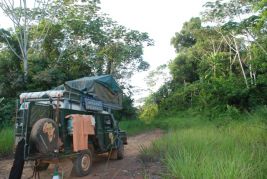
Bush camp on the equator
The track that continues has some potholes but overall is in good condition. We arrive early, it is 13:30, and the guardian at Lopè Park is very full of himself and most impolite.
The park costs 5000 each, 15000 for the car and 10000 for a guide.
However, there isn’t room for a guide in our car. Therefore, we carry on until 17:30 when we arrive at a nice bush camp that is in the heart of the splendid forest far away from the road.
A half moon illuminates the night sky with the sound of forest animals in the background.
GPS S0°32.910 E12°10.818
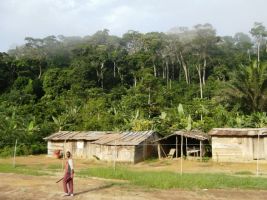
Towards Franceville
This forest is really imposing.
The track opens up between enormous walls of vegetation; remote villages are few and far between.
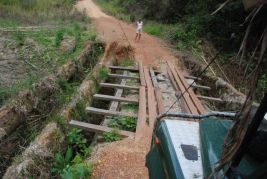
On The Elephants’ Trail.
We camp in Franceville at the MASOKU restaurant, we are allowed to camp free of charge in the lovely garden with a swimming pool.
GPS S01°37.940' E013°35.130'
A worker tells us about the elephants in the forest, all about his village and of the Pisteur (people who know the trails of the elephants; pista=trail) who accompany people to follow the elephant trails. We decide to go on this walking tour down this rarely used track.
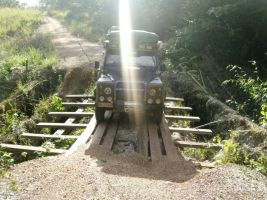
Some bridges certainly can give you the heebie-jeebies, but a sign from “above”, makes us believe that we are on the right track…
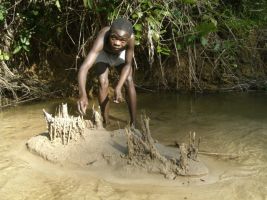
Along the track, we cross various clear water brooks and small rivers.
We arrive in Ossele at sunset, contact the head of the Pisteur, and plan the hike for the following day.
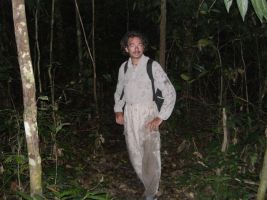
Along The Elephants’ Trail
We wake very early and leave just before sunrise.
The temperature is good but humid.
The rain that fell during the night has drenched the forest, which in turn drenches our clothes.
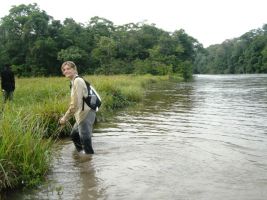
After about an hour of footslogging, we arrive at a riverbank.
However, the riverbank has moved a few metres in towards the woods.
We come upon various fords and marshes.
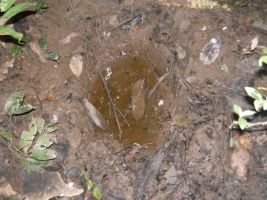
Just Elephant Prints
Nothing!
It appears the elephants have migrated. This is all we manage to see after about three hours of hiking in the scrub - some footprints from about a month ago.
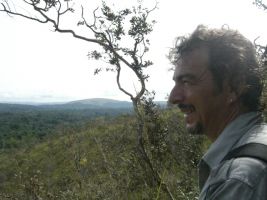
We return to the village, somewhat disappointed and very wet and try to continue along the main off-road track.
In fact, 10km further ahead, so we are told, there is an American woman who runs a centre that is studying gorillas.
The Lize Park.
After about 3km the track becomes sandy, the forest starts to get tighter and the ground inclines steeply to the side.
With all the weight on top of K7, we risk tipping over on to the rocks that border the road...
We decide to go back.
What a day!
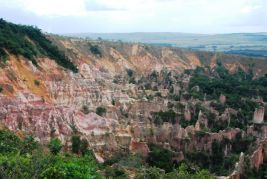
Lekoni – 17 April 2008
We head towards the Congo frontier and reach the cirque of Lekoni, famous for its coloured canyons similar to the Bryce canyons in the U.S.A
We get the impression that this country more than its fair share of cantankerous folk. No one tells us how to reach the canyons, and this is further hampered by the lack of road signs.
Everybody likes to improvise as a guide.
All you have to do is exit the town following the road that leads towards the frontier and as you get to the fifth kilometre, take a right on to a sandy track.
After a few more kilometres, you arrive.
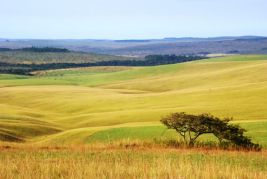
The panorama is very different. Lovely rolling hills as far as the eye can see, covered in grass.
It reminds me of Franco Fontana’s Tuscany.
The formalities to exit Gabon are carried out in Lekoni. The police are on the road. The customs building is just before in the “eau claire” area. The office was closed but luckily, a relative of the customs officer who lived near by went to the village to fetch him.
Two punches later – of the ticket that is - and we are off…
Although, the real frontier is 25km ahead, out of the town.
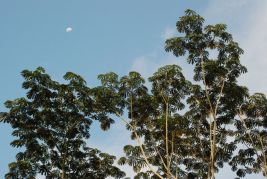
Our Impressions
There is so much forest in this country!
The equator crosses it and you can tell. There are few inhabitants for such a vast territory and they are concentrated in small areas.
The main roads are passable with a normal vehicle. Some have been freshly asphalted but others have dangerous potholes. Much better and often more comfortable are the tracks that have been remade.
These secondary roads come from Camel Trophy. A collapsed bridge sometimes interrupts these over a torrent.
In fact, road works are very commonplace, with many sites run by Chinese workers.
Overall, the country is tranquil and safe. Generally, people come across as not very cheerful and are sometimes a little… well, vacant.
There are still many “ritual” beliefs even amongst people of high social position… and, those scabrous, heinous human sacrifices (affirmation documented).
For forty years the president has been in power, during which he has brought some stability. There is a middle class that has been the driving force behind social peace, which is useful, seeing how easy lethal riots can start in Africa.
It is a very expensive place with very few tourists.
We found a very relaxed police force and apart from an officer in the north that made up an imaginary municipal tax that we paid, we were never asked for gifts…
Often, not even our documents, only where we were going.
There are few checks and few barriers along the roads.
For the first time we encounter the notorious Furu.

